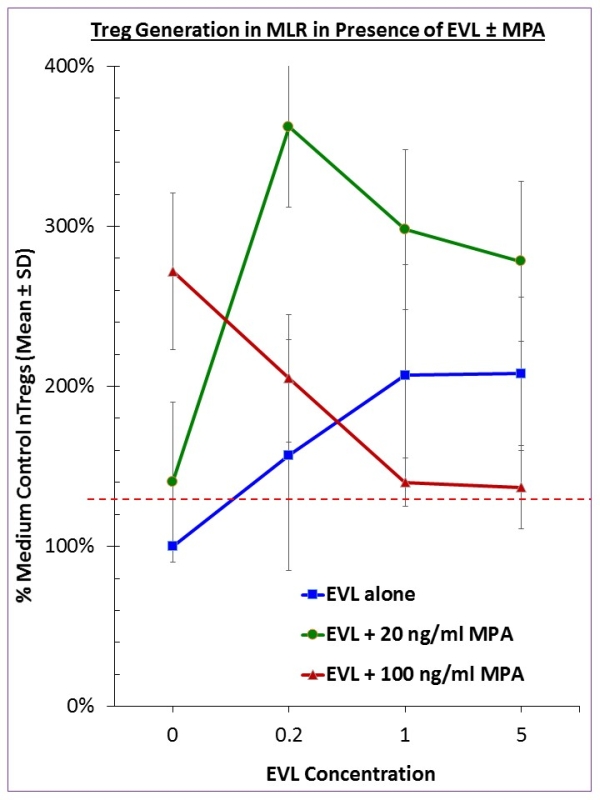Relative In Vitro Immunoregulatory Effects of Everolimus, Sirolimus, Tacrolimus, Mycophenolic Acid and Drug Combinations
Surgery - Comprehensive Transplant Center, Northwestern University Feinberg School of Medicine, Chicago, IL.
Meeting: 2015 American Transplant Congress
Abstract number: A271
Keywords: Immunosuppression, Lymphocyte activation, T cell reactivity, Tolerance
Session Information
Session Name: Poster Session A: Preclinical Immunosuppression and Tolerance
Session Type: Poster Session
Date: Saturday, May 2, 2015
Session Time: 5:30pm-7:30pm
 Presentation Time: 5:30pm-7:30pm
Presentation Time: 5:30pm-7:30pm
Location: Exhibit Hall E
Everolimus (EVL) is a modified form of the mTOR-inhibitor Sirolimus (SRL) and is used clinically in combination with Mycophenolate (MMF) and/or Tacrolimus (TAC). The purpose of the study was to determine in vitro the relative effects of EVL, SRL, TAC and MPA (the in vivo active form of Mycophenolate) as well as EVL plus TAC or EVL plus MPA on lymphoproliferation and regulatory T cell generation.
Increasing concentrations of EVL, SRL, MPA and TAC and alone or in combination were added to MLRs of healthy volunteers and assessed the lymphoproliferation by 3H-TdR incorporation and the percentage of newly generated CD4+CD127-CD25HighFOXP3+ (nTregs) in CFSE labeled responder cells by flow cytometry.
In comparison to medium controls, EVL and other drugs dose-dependently but at varying impact inhibited lymphoproliferation in HLA 2-DR matched and mismatched MLRs (n = 3 -10). However, the effect of the drugs on the generation of new nTregs by using CFSE labeled responder cells in flow cytometry differed considerably. When compared to medium controls, EVL even at therapeutic concentrations significantly amplified nTreg generation (p<0.05), while SRL and MPA had this effect only at sub-therapeutic concentrations and even inhibited at therapeutic levels. TAC, in contrast, inhibited newly generated nTregs at all concentrations thus confirming our previous results. Combinations of EVL plus MPA inhibited proliferation and amplified the generation of nTregs in an additive manner, when compared to medium controls or each drug tested alone (p<0.05). However, when tested in combination with TAC, EVL failed to reverse the inhibition of nTreg generation mediated by TAC.
In conclusion, the relative tolerogenic effect from high to low was EVL > MPA > SRL > TAC. If the results from these in vitro studies are extrapolated to the clinical situation, it would suggest EVL plus low concentrations of MPA (MMF) may be the most tolerogenic combination. 
To cite this abstract in AMA style:
Mathew J, Huang X, Leventhal J, Gallon L, Miller J, Levitsky J. Relative In Vitro Immunoregulatory Effects of Everolimus, Sirolimus, Tacrolimus, Mycophenolic Acid and Drug Combinations [abstract]. Am J Transplant. 2015; 15 (suppl 3). https://atcmeetingabstracts.com/abstract/relative-in-vitro-immunoregulatory-effects-of-everolimus-sirolimus-tacrolimus-mycophenolic-acid-and-drug-combinations/. Accessed January 7, 2026.« Back to 2015 American Transplant Congress
